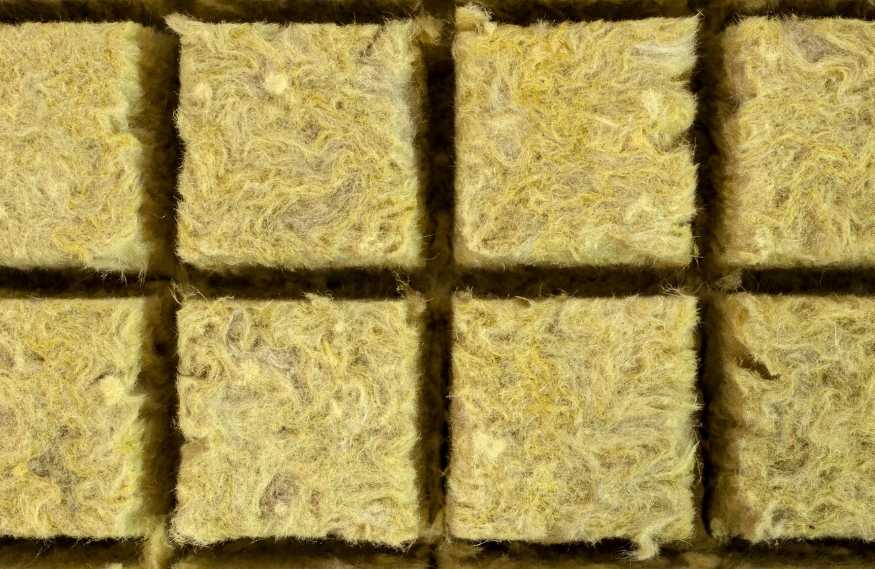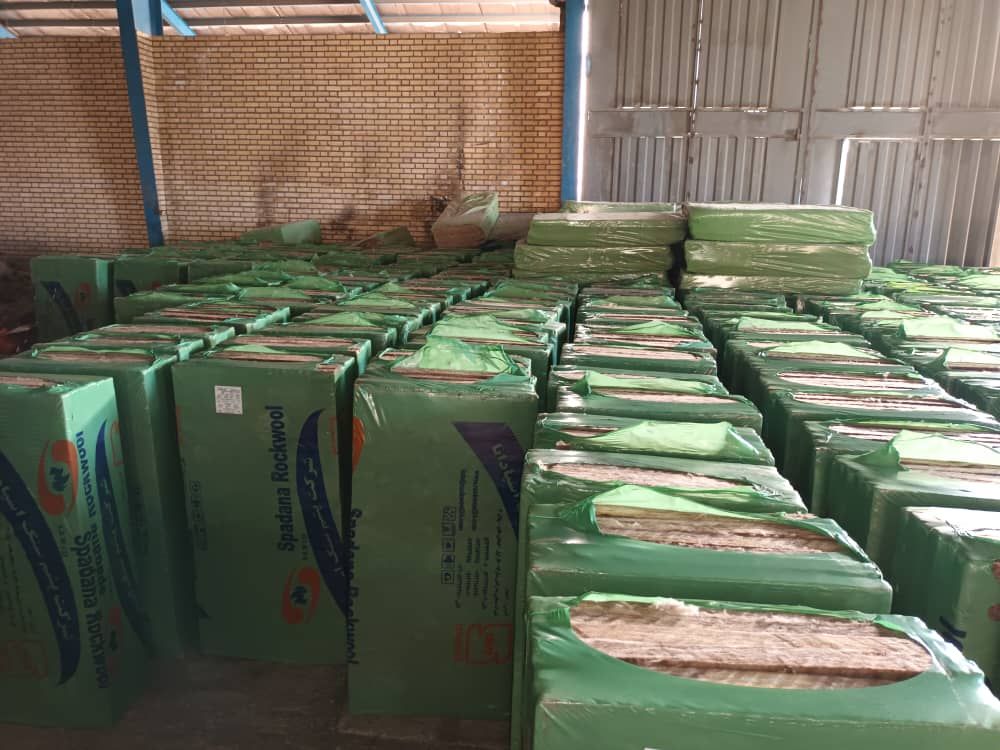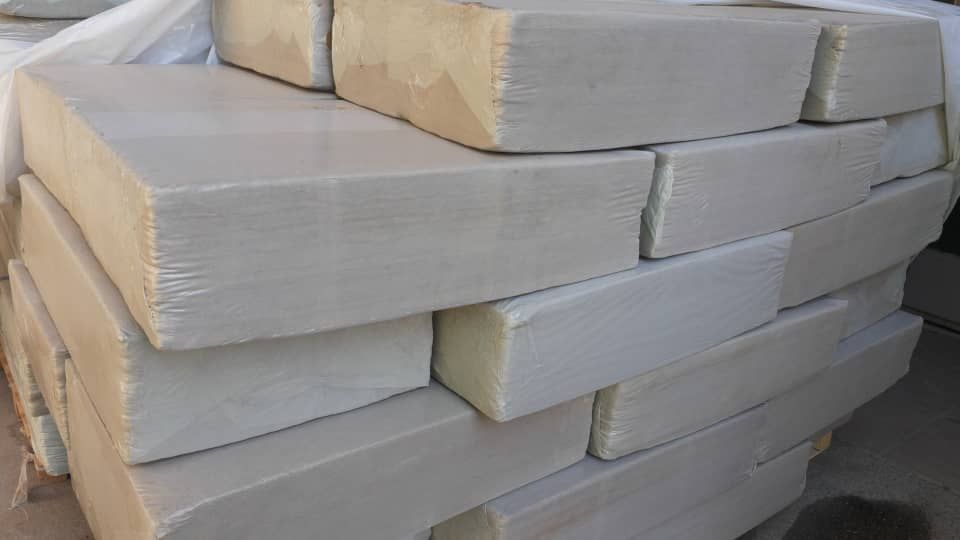From the combination of basalt or dolomite, which is the result of volcanic activities, together with coke and slag, melted at 1450 degrees Celsius in special furnaces, a material called molten silicate is formed. Special fibers are spun under the high pressure of air flow and become fibers with diameters of 6 to 8 microns, which are called rock wool insulation. Rock wool insulation is also called mineral wool.
After production, stone wool insulation is supplied in various sizes and shapes according to the order.
Types of stone wool:
- Rolled stone wool (quilted stone wool or coated stone wool)
- Panel rock wool (sheet rock wool or slate rock wool)
- Stone wool with lace or blanket
- Stone wool pipe insulation or prefabricated tubular stone wool
Rolly stone wool:
Stone wool rolls or quilts are produced and supplied in standard dimensions of 1.2 meters in width and 10 meters in length and thicknesses between 3 and 8 cm in densities of 25 kg to 60 kg. It goes without saying that only thicknesses of 2 cm and 5 cm are available. They are normally produced and other thicknesses are produced in large quantities according to the customer’s order.
There are three types of rock wool, which are:
- Foiled stone wool or stone wool with reinforced aluminum coating.
- Paper rock wool or rock wool with kraft paper coating.
- Bare or uncoated stone wool.
The most widely used rock wool insulation is its coated type, which is used by the public in wet areas.
Stone wool with lace:
Stone wool with lace or blanket in standard dimensions of 1.2 meters wide and 5 meters long (the length of stone wool with lace varies according to its thickness) in thickness between 3 and 10 cm and density between 50 and 150 kg/m3 It is produced and supplied.
For easier packing of stone wool in high thicknesses, the length of the stone wool is reduced to 3 meters. It goes without saying that the higher the density of the stone wool, the better quality insulation we will benefit from. Rolled stone and rock wool are used less often because this insulation is used in special cases, which include:
- Insulation of pipes with high diameters
- Insulation of industrial equipment, machines, etc.
Tubular wool:
Tubular stone wool is produced in standard diameters of pipes available in Iran in various thicknesses and lengths. As the name suggests, rock wool or prefabricated pipe insulation is used to insulate pipes in construction and industrial facilities.
Hydroponic rock wool:
Hydroponic rock wool is actually the same as slate rock wool, with the difference that hydroponic rock wool has a lower density, and this factor has made it highly useful in agricultural applications. Hydroponic rock wool, due to its low density, It has caused the amount of oxygen penetration to increase, which causes proper ventilation in the root bed of plants.
Now that the society is facing the risk of drought and lack of water, the best way to save water is to help plants so that they do not face water shortages, and also to prevent frequent withdrawals from underground water, wells, and existing water. On the surface of the ground, the use of hydroponic stone wool is used in plant beds. The stone wool used in plant beds makes these beds have high humidity and higher water absorption than other beds.
Today, one of the creative methods of planting plants and agricultural products is the use of hydroponic stone wool or hydroponic planting (water cultivation), because in this method the plant can grow without using soil and water with a smaller amount. It should be noted that in this The method of planting, the plant is injected using nutrient solutions that are connected to the hydroponic stone wool through a dropper in the plant bed, and the plant can receive all its nutrients well.
Hydroponic stone wool can be used in spaces such as greenhouses, production of various vegetables, all kinds of greenhouses and planting all kinds of flowers.
Advantages of stone wool:
- Stone wool insulation, unlike glass wool insulation, does not cause skin irritation and lung damage.
- Stone wool is not carcinogenic like glass wool.
- It has a high thermal conductivity coefficient.
- It has high resistance to moisture and can keep moisture in itself well, which has made this insulation to be used well in agricultural applications.
- Durability of stone wool insulation compared to other insulations (for example: polymer foams have lower durability against heat and cold and lose their shape and efficiency over time). Time does not change its shape and size as well as its quality in front of preventing the loss of heat and cold.
- Stone wool is the best insulation against heat (thermal insulation stone wool)
- Stone wool is the best insulation against sound (sound insulation stone wool)
- Acoustic features
| Type and function of insulation | Relevant international standards |
| performance against corrosion | ASTM C795, ASTMC871, ASTM C692, ASTM C665 |
| Resistance to fire and heat | ASTM E 84, ASTM E119, ASTME136 |
| Coefficient performance and thermal conductivity | ASTM C680, DIN 52271/ AGI Q 132 |
| Performance against static and pressure | ASTM C165,ASTM C354 |
| Dimensional stability performance | ASTM C356, ASTM C167 |
| Acoustic and acoustic performance | ASTM C423 |
| Performance versus operating temperature | ASTM C411 |
| Moisture resistance | ASTM C1104 |
| Performance versus flexibility | ASTM C111 |
| Environmental performance of the production line | ASTM D6523 |
| Composition | Abbreviation | Composition percentage |
| Silicon Oxide | Sio2 | 32 to 38% |
| Aluminum Oxide | AI203 | 12 to 15% |
| Iron Oxide | Fe203 | 3 to 5% |
| Calclum Oxide | CaO | 16 to 20% |
| Magnesium Oide | Mgo | 7 to 11% |
| Sodium oxd + potassium oxide | Na2o+K2o | 3 to 5% |
| Titanium Oxide | Tio2 | 1 to 2% |
| sulfur (III) oxide | So3 | Less than 2% |
| ITEM | UNIT | INDEX | EPRIMENT METHOD |
| DENITY | KG/M3 | 80-180 | ASTMC167 |
| THIKNESS | mm | 20-100 | ASTMC167 |
| LENGTH | mm | According to Customer | ASTMC167 |
| WIDTH | mm | 600-1000-1200 | ASTMC167 |
| FACING | —– | With wire mesh – with aluminum foil- with craft paper- wire mesh both side. | |
| AVERAGE VALUE OF FIBER | micron | micron 4-10 | ASTMC592 |
| AVERAGE LENGTH OF FIBER | mm | 20-60 | ————- |
| NON FIBEROUS CONTENT | %WEIGHT | Less than 30% | ASTMC1335 |
| Linear Shirinkage | % | Less than 4% | ASTMC356 |
| FIRE PEROPERTIES | class | A1 | ASTMC1320 |
| CLORIDE CONTENT | ppm | Less than 11 | ASTMC871 |
| PH | – | Greater than 7 and less than 11.7 | |
| SERVICE TEMPRATURE | C | 750 c | ASTMC447 |
| HOT SURFACE PERFORMANCE | C | 350-850 c | ASTMC411 |
| THERMAL CONDUCTIVITY | W/Mk | 0.044 at 150 c DENSITY=120kg/m3 | ASTMC518 |
| CHEMICAL ANALYSIS | %WEIGHT ASTME1621 | SIOZ=30-40, Mgo=4-15, TIOZ=0.1-5,Cao=33-42, Fe203=8-18, K20=1-5, Mmo=0-5 |
Rock wool insulation can prevent sound transmission in two ways:
- Using its internal components and structure.
- Using your level.
Rock wool insulation can prevent sound from spreading and passing through walls and ceilings, etc. It should also be considered that noise pollution can be caused by mechanical shocks, air vibration, etc. To prevent it, all noise pollution should be investigated and finally, a more suitable sound insulation should be prepared so that we can benefit from a better result).
9.Water disposal
(To use rock wool against moisture, you must first cover the rock wool with a coating that does not absorb moisture and then use it. The rock wool insulation with the coating does not absorb moisture, but repels it).
10- Performance against fire
(One of the important features of stone wool insulation is its high resistance to fire because it does not ignite, but acts as a kind of protection against fire. Insurance companies for buildings that use wool for the main structures and columns of the building. Insulating stone, when there is a fire, they get higher discounts than doing its reconstruction.
The best thing to do to prevent fire and complete collapse of building structures is to use rock wool insulation. If metal structures are exposed to high heat, they lose their mechanical resistance and change shape, which causes the collapse of the entire building. . This is why it is emphasized to insulate the main structures because in this case, even if the fire lasts for hours, no problem will occur to the main structures of the building and it will prevent it from collapsing.
The buildings that are located on the oil platforms are completely insulated with stone wool insulation in advance so that in the event of a fire they have a safe place to stay until the helpers arrive).
11- compatibility with the environment
(Unlike all insulations available in the market, stone wool insulation is the most harmless and compatible insulation against the environment and construction industries and other facilities because it is compatible with all materials and its contact with electric cables and pipes with PV coating C is not dangerous).
12- Biological characteristics
(Stone wool has sterilized fibers, which made banana insects, bacteria and fungi unable to penetrate into stone wool).
13- health and safety
(According to the World Health Organization, stone wool is not carcinogenic and does not cause any danger such as lung damage or skin sensitivities, nor does it produce toxic substances due to fire. According to European standards, breathing in An environment that contains five milligrams per cubic meter of stone wool will not cause any health problems for up to 8 hours
does not have).
14- thermal conductivity
(One of the most important characteristics of stone wool insulation for saving energy consumption is its conductivity. The lower the thermal conductivity, the better quality insulation is. A layer of stone wool with a thickness of 5 cm is like a brick wall. The thickness of 1 meter is resistant to heat and cold. The performance of thermal insulation is such that it keeps the environment that is hot still warm and the environment that is cold still cold. This has made it to be named the best insulator among insulators).
15- Operating temperature range
Stone wool products have high resistance to temperatures between -250 and +800, stone wool fibers do not ignite when exposed to direct heat for up to 4 hours because its melting point is more than 1200 degrees Celsius, this factor has made it possible to work have a constant temperature between -150 and +700. Most rock wool products decompose at a temperature of +220 degrees Celsius, but they do not change the thermodynamic properties of the insulation. Rock wool insulation is resistant to temperatures above +700 degrees. Celsius is used in oil refineries, power plants, petrochemical complexes, cement industries and heavy industries that require very precise and high quality insulation).




